“讲学稿”
- 格式:doc
- 大小:15.77 KB
- 文档页数:8
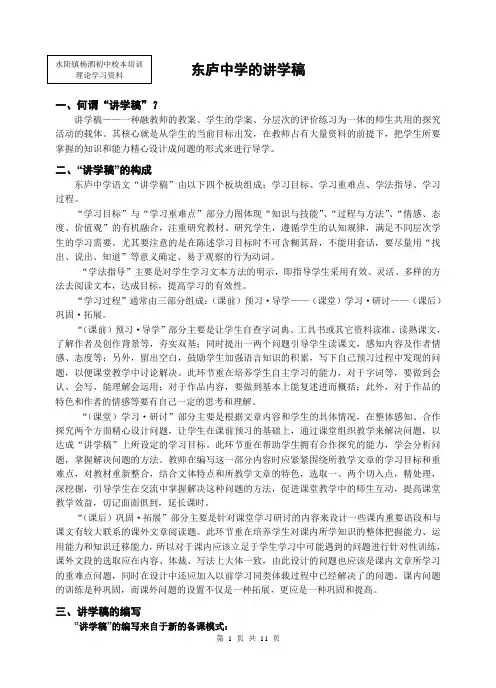
一、何谓“讲学稿”?讲学稿——一种融教师的教案、学生的学案、分层次的评价练习为一体的师生共用的探究活动的载体。
其核心就是从学生的当前目标出发,在教师占有大量资料的前提下,把学生所要掌握的知识和能力精心设计成问题的形式来进行导学。
二、“讲学稿”的构成东庐中学语文“讲学稿”由以下四个板块组成:学习目标、学习重难点、学法指导、学习过程。
“学习目标”与“学习重难点”部分力图体现“知识与技能”、“过程与方法”、“情感、态度、价值观”的有机融合,注重研究教材、研究学生,遵循学生的认知规律,满足不同层次学生的学习需要。
尤其要注意的是在陈述学习目标时不可含糊其辞,不能用套话,要尽量用“找出、说出、知道”等意义确定、易于观察的行为动词。
“学法指导”主要是对学生学习文本方法的明示,即指导学生采用有效、灵活、多样的方法去阅读文本,达成目标,提高学习的有效性。
“学习过程”通常由三部分组成:(课前)预习·导学——(课堂)学习·研讨——(课后)巩固·拓展。
“(课前)预习·导学”部分主要是让学生自查字词典、工具书或其它资料读准、读熟课文,了解作者及创作背景等,夯实双基;同时提出一两个问题引导学生读课文,感知内容及作者情感、态度等;另外,留出空白,鼓励学生加强语言知识的积累,写下自己预习过程中发现的问题,以便课堂教学中讨论解决。
此环节重在培养学生自主学习的能力,对于字词等,要做到会认、会写、能理解会运用;对于作品内容,要做到基本上能复述进而概括;此外,对于作品的特色和作者的情感等要有自己一定的思考和理解。
“(课堂)学习·研讨”部分主要是根据文章内容和学生的具体情况,在整体感知、合作探究两个方面精心设计问题,让学生在课前预习的基础上,通过课堂组织教学来解决问题,以达成“讲学稿”上所设定的学习目标。
此环节重在帮助学生拥有合作探究的能力,学会分析问题,掌握解决问题的方法。
教师在编写这一部分内容时应紧紧围绕所教学文章的学习目标和重难点,对教材重新整合,结合文体特点和所教学文章的特色,选取一、两个切入点,精处理,深挖掘,引导学生在交流中掌握解决这种问题的方法,促进课堂教学中的师生互动,提高课堂教学效益,切记面面俱到,延长课时。
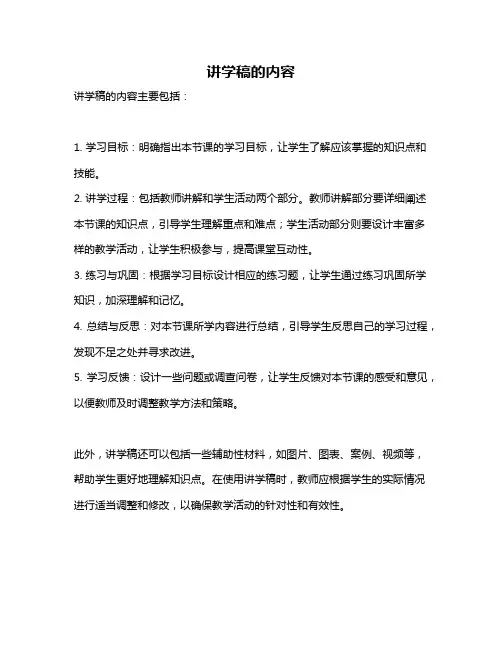
讲学稿的内容
讲学稿的内容主要包括:
1. 学习目标:明确指出本节课的学习目标,让学生了解应该掌握的知识点和技能。
2. 讲学过程:包括教师讲解和学生活动两个部分。
教师讲解部分要详细阐述本节课的知识点,引导学生理解重点和难点;学生活动部分则要设计丰富多样的教学活动,让学生积极参与,提高课堂互动性。
3. 练习与巩固:根据学习目标设计相应的练习题,让学生通过练习巩固所学知识,加深理解和记忆。
4. 总结与反思:对本节课所学内容进行总结,引导学生反思自己的学习过程,发现不足之处并寻求改进。
5. 学习反馈:设计一些问题或调查问卷,让学生反馈对本节课的感受和意见,以便教师及时调整教学方法和策略。
此外,讲学稿还可以包括一些辅助性材料,如图片、图表、案例、视频等,帮助学生更好地理解知识点。
在使用讲学稿时,教师应根据学生的实际情况进行适当调整和修改,以确保教学活动的针对性和有效性。
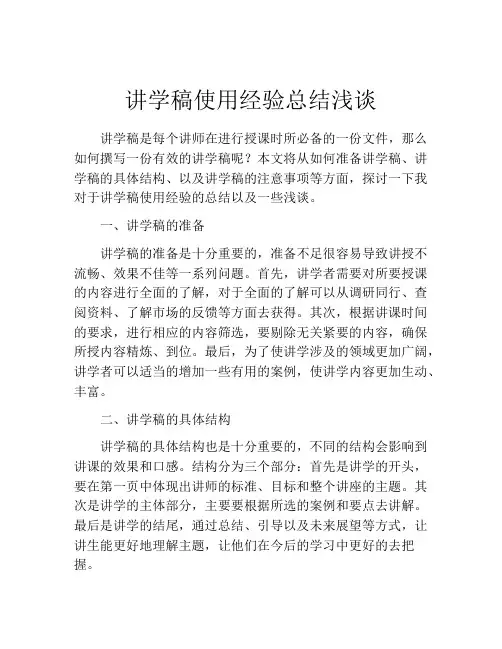
讲学稿使用经验总结浅谈讲学稿是每个讲师在进行授课时所必备的一份文件,那么如何撰写一份有效的讲学稿呢?本文将从如何准备讲学稿、讲学稿的具体结构、以及讲学稿的注意事项等方面,探讨一下我对于讲学稿使用经验的总结以及一些浅谈。
一、讲学稿的准备讲学稿的准备是十分重要的,准备不足很容易导致讲授不流畅、效果不佳等一系列问题。
首先,讲学者需要对所要授课的内容进行全面的了解,对于全面的了解可以从调研同行、查阅资料、了解市场的反馈等方面去获得。
其次,根据讲课时间的要求,进行相应的内容筛选,要剔除无关紧要的内容,确保所授内容精炼、到位。
最后,为了使讲学涉及的领域更加广阔,讲学者可以适当的增加一些有用的案例,使讲学内容更加生动、丰富。
二、讲学稿的具体结构讲学稿的具体结构也是十分重要的,不同的结构会影响到讲课的效果和口感。
结构分为三个部分:首先是讲学的开头,要在第一页中体现出讲师的标准、目标和整个讲座的主题。
其次是讲学的主体部分,主要要根据所选的案例和要点去讲解。
最后是讲学的结尾,通过总结、引导以及未来展望等方式,让讲生能更好地理解主题,让他们在今后的学习中更好的去把握。
三、讲学稿的注意事项讲学稿是非常重要的一份文件,因此要注意下列事项:1. 要灵活应变无论经验还是内容,讲学稿都需要灵活应变。
讲师可以根据实际情况随时对讲文做出调整,并在此基础上进行对学生的引导、补充等操作。
为了让讲学更加通俗易懂,讲师还可以利用大量的生动案例。
2. 要花时间练习在讲学前要对讲学稿进行充分的练习,以此来增强讲课信心和手感。
此外,在讲学中也要注意互动、观察学生反应,为他们提供鼓励和支持,以此来建立良好的师生关系。
3. 要保持专业在讲学时需要注意保持专业,从不同的角度来讲解问题。
讲学者应该不断吸取新资讯,丰富自身的经验,以此来提高自身的能力和专业度。
同时,讲师还应该注重讲学风格的平衡,避免过于生硬或过于热情。
四、结语综上所述,讲学稿的使用经验是讲学者在接手授课任务的过程中必须掌握的技能。
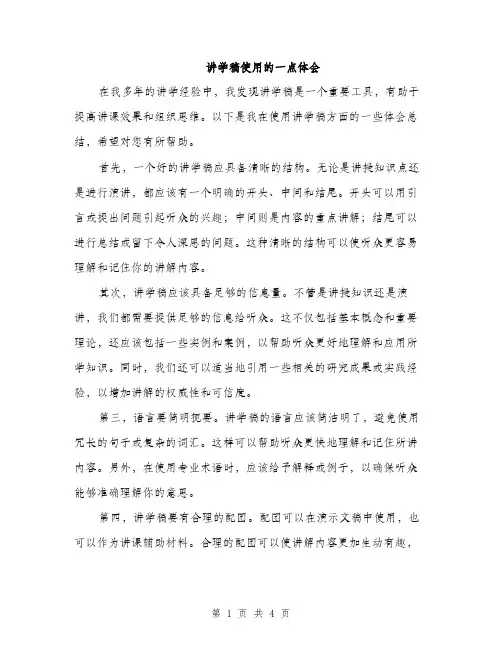
讲学稿使用的一点体会在我多年的讲学经验中,我发现讲学稿是一个重要工具,有助于提高讲课效果和组织思维。
以下是我在使用讲学稿方面的一些体会总结,希望对您有所帮助。
首先,一个好的讲学稿应具备清晰的结构。
无论是讲授知识点还是进行演讲,都应该有一个明确的开头、中间和结尾。
开头可以用引言或提出问题引起听众的兴趣;中间则是内容的重点讲解;结尾可以进行总结或留下令人深思的问题。
这种清晰的结构可以使听众更容易理解和记住你的讲解内容。
其次,讲学稿应该具备足够的信息量。
不管是讲授知识还是演讲,我们都需要提供足够的信息给听众。
这不仅包括基本概念和重要理论,还应该包括一些实例和案例,以帮助听众更好地理解和应用所学知识。
同时,我们还可以适当地引用一些相关的研究成果或实践经验,以增加讲解的权威性和可信度。
第三,语言要简明扼要。
讲学稿的语言应该简洁明了,避免使用冗长的句子或复杂的词汇。
这样可以帮助听众更快地理解和记住所讲内容。
另外,在使用专业术语时,应该给予解释或例子,以确保听众能够准确理解你的意思。
第四,讲学稿要有合理的配图。
配图可以在演示文稿中使用,也可以作为讲课辅助材料。
合理的配图可以使讲解内容更加生动有趣,激发听众的兴趣和注意力。
同时,配图也可以帮助听众更好地理解和记忆所学知识。
第五,讲学稿需要经常修订和更新。
随着时代的发展和知识的更新,我们要不断修订和更新讲学稿,以保证所讲内容的准确性和权威性。
此外,不同的听众可能对不同的内容感兴趣,因此,我们可以根据听众的需求进行相应的调整和补充。
最后,一个好的讲学稿并不是万能的。
在讲授过程中,我们还要根据具体情况进行灵活调整和应对。
有时候,讲学稿可能需要做一些修改或省略,以适应实际情况。
此外,我们还要善于运用一些教学技巧和方法,例如提问、互动等,以增强讲解效果。
总之,一个好的讲学稿对于提高讲课效果和组织思维非常重要。
以清晰的结构、充足的信息、简明扼要的语言和合理的配图为基础,经常修订和更新,并灵活应对实际情况,会使我们的讲课更加生动有趣,更加深入人心。

郭原初中七年级语文上册讲学稿 主备人:贾睿 参与人:贾永良 蒋召召 审核人:张志清名言警句:最可怕的敌人,就是没有坚强的信念。
——斯宾塞一、课前准备。
1、查字典,读准下列加线字的音并识记词语意思。
妮( )莎 ( ) 捡 ( )截然 ( ) 感慨 ( ) 抚弄( ) 绽开( ) 唯恐( ) 争执( ) 激荡( ) 不求甚解( )混为一谈( )美不胜收( ) 搓捻( ) 花团锦c ù( )惭ku ì( )疲惫不 k ān( )小心y ì( )hu ǎng 然大悟( ) 花团锦簇: 美不胜收: 繁花似锦: 风云突变: 不可名状: 期期艾艾:2、你认为还有那些比较重要的(或需要提醒同学们注意的)词语,请写在下面空白处。
二、课堂学习。
1、文题“再塑生命”从字面意思看,是“重新塑造生命、重新获得生命”的意思。
文中它的深刻含意是什么?表达了作者怎样的思想感情?2、谈谈你对莎莉文老师的了解。
三、随堂检测。
1.下列书写正确的一项是( )A .穿棱 困惑不解 搓捻 不可名状B .迁徒 繁花似锦 觅食 期期艾艾C .企盼 美不胜收 遨游 落英缤纷D .繁衍 冥思苦想 惭愧 风云凸变 2.根据意思写词语。
(1)形容口吃。
_____________(2)美好的东西太多,一时接受不完(看不过来)。
_____________ (3)形容思想感情自然而然地产生。
_____________(4)不能够用语言形容。
_____________ (5)情况变化非常快。
_____________ 3.以“爱”为话题,模仿例句写几句话。
例:爱是什么?爱是花的香味吗? 爱是太阳吗?爱有点像太阳没出来以前天空中的云彩。
____________________________________________________ ____________________________________________________ 四、拓展延伸。
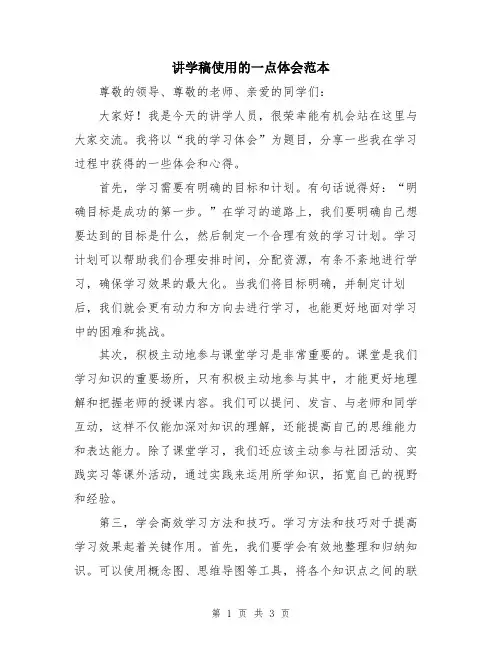
讲学稿使用的一点体会范本尊敬的领导、尊敬的老师、亲爱的同学们:大家好!我是今天的讲学人员,很荣幸能有机会站在这里与大家交流。
我将以“我的学习体会”为题目,分享一些我在学习过程中获得的一些体会和心得。
首先,学习需要有明确的目标和计划。
有句话说得好:“明确目标是成功的第一步。
”在学习的道路上,我们要明确自己想要达到的目标是什么,然后制定一个合理有效的学习计划。
学习计划可以帮助我们合理安排时间,分配资源,有条不紊地进行学习,确保学习效果的最大化。
当我们将目标明确,并制定计划后,我们就会更有动力和方向去进行学习,也能更好地面对学习中的困难和挑战。
其次,积极主动地参与课堂学习是非常重要的。
课堂是我们学习知识的重要场所,只有积极主动地参与其中,才能更好地理解和把握老师的授课内容。
我们可以提问、发言、与老师和同学互动,这样不仅能加深对知识的理解,还能提高自己的思维能力和表达能力。
除了课堂学习,我们还应该主动参与社团活动、实践实习等课外活动,通过实践来运用所学知识,拓宽自己的视野和经验。
第三,学会高效学习方法和技巧。
学习方法和技巧对于提高学习效果起着关键作用。
首先,我们要学会有效地整理和归纳知识。
可以使用概念图、思维导图等工具,将各个知识点之间的联系和逻辑关系整理清晰,便于记忆和理解。
其次,我们可以采用分段学习的方法,将学习任务分成若干个小块,每次只集中注意力学习一个小块,这样能够提高学习的效率和记忆的持久性。
另外,合理运用信息技术也是提高学习效果的一个重要途径。
我们可以使用电子书、教学软件、互联网等途径获取信息,同时要学会筛选和整理所获取的信息,避免陷入过多的信息噪音中。
第四,保持良好的学习习惯和学习态度。
学习习惯是我们学习的基础,只有培养良好的学习习惯,才能持之以恒地进行学习。
比如,每天定时定量地复习课堂知识,每日安排一定的阅读时间,养成写作和思考的习惯等等。
同时,保持积极向上的学习态度也是很重要的。
学习并不是一段轻松的旅程,其中会遇到各种困难和挫折。
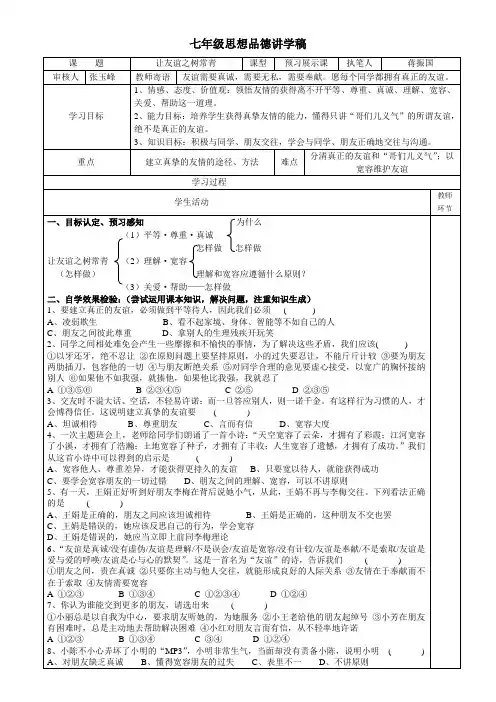
七年级思想品德讲学稿
答案
二、自学效果检验
CCCAC BCB
三、合作研讨
1、(1)我会原谅他,因为他不是故意的。
(2)我不会“帮”他,因为考试作弊是一种违纪行为。
(3)我会拒绝他,因为未成年人去网吧是违反法律法规的行为。
(4)我不会原谅他,因为朋友之间的理解与宽容是讲究原则的,朋友的这种恶意欺诈行为违背了道德甚至法律。
2、判断:错误。
理由:理解宽容是一种美德,朋友之间的理解、宽容,并不是可以不讲原则,建立真正的友谊必须以分清正确与错误、正义与邪恶为前提,对待“坏人”我们决不能迁就,在原则上决不让步。
3、(1)刘婷的做法不对,好朋友之间应相互尊重、相互帮助,不开出格的玩笑,不伤害对方的自尊心。
(2)刘婷应主动向王美道歉,承认自己的过失,并真诚帮助王美,征得王美的原谅,王美要理解宽容对方,不能因小事而斤斤计较,原谅对方、接纳对方。
(3)①平等相待、相互尊重、真诚交流;②理解宽容;③对方遇到困难和需要帮助时,要积极的伸出援助之手。
四、拓展延伸,能力提高
(1)如:积极交往,建立友谊;相逢是首歌;友情伴我同行等。
(2)如:让友谊之树常青;让我们到处都有好朋友等。
(3)召开主题班会、举行演讲比赛、办一期黑板报或手抄报等。
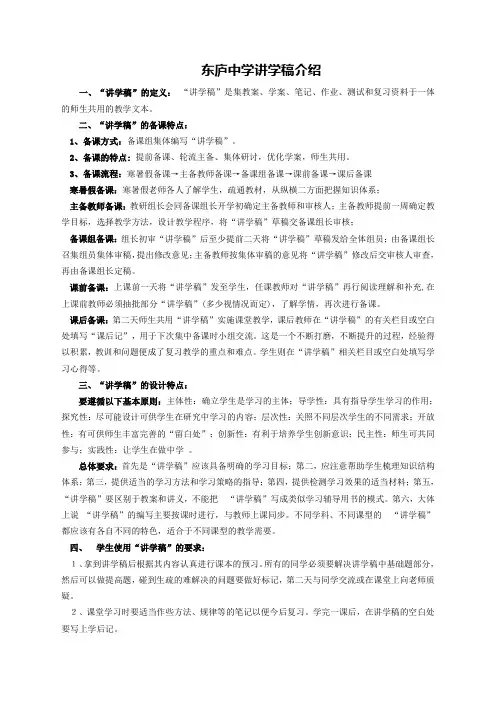
东庐中学讲学稿介绍一、“讲学稿”的定义:“讲学稿”是集教案、学案、笔记、作业、测试和复习资料于一体的师生共用的教学文本。
二、“讲学稿”的备课特点:1、备课方式:备课组集体编写“讲学稿”。
2、备课的特点: 提前备课、轮流主备、集体研讨,优化学案,师生共用。
3、备课流程:寒暑假备课→主备教师备课→备课组备课→课前备课→课后备课寒暑假备课:寒暑假老师各人了解学生,疏通教材,从纵横二方面把握知识体系;主备教师备课:教研组长会同备课组长开学初确定主备教师和审核人;主备教师提前一周确定教学目标,选择教学方法,设计教学程序,将“讲学稿”草稿交备课组长审核;备课组备课:组长初审“讲学稿”后至少提前二天将“讲学稿”草稿发给全体组员;由备课组长召集组员集体审稿,提出修改意见;主备教师按集体审稿的意见将“讲学稿”修改后交审核人审查,再由备课组长定稿。
课前备课:上课前一天将“讲学稿”发至学生,任课教师对“讲学稿”再行阅读理解和补充,在上课前教师必须抽批部分“讲学稿”(多少视情况而定),了解学情,再次进行备课。
课后备课:第二天师生共用“讲学稿”实施课堂教学,课后教师在“讲学稿”的有关栏目或空白处填写“课后记”,用于下次集中备课时小组交流。
这是一个不断打磨,不断提升的过程,经验得以积累,教训和问题便成了复习教学的重点和难点。
学生则在“讲学稿”相关栏目或空白处填写学习心得等。
三、“讲学稿”的设计特点:要遵循以下基本原则:主体性:确立学生是学习的主体;导学性:具有指导学生学习的作用;探究性:尽可能设计可供学生在研究中学习的内容;层次性:关照不同层次学生的不同需求;开放性:有可供师生丰富完善的“留白处”;创新性:有利于培养学生创新意识;民主性:师生可共同参与;实践性:让学生在做中学。
总体要求:首先是“讲学稿”应该具备明确的学习目标;第二,应注意帮助学生梳理知识结构体系;第三,提供适当的学习方法和学习策略的指导;第四,提供检测学习效果的适当材料;第五,“讲学稿”要区别于教案和讲义,不能把“讲学稿”写成类似学习辅导用书的模式。
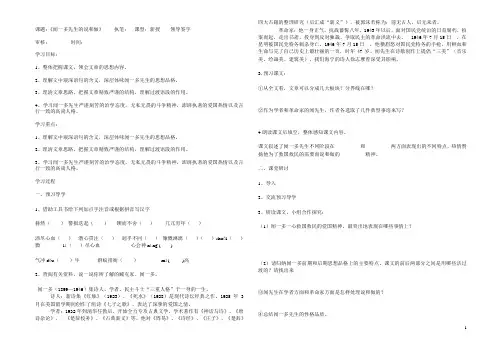
课题:《闻一多先生的说和做》执笔:课型:新授领导签字审核:时间:学习目标:1、整体把握课文,领会文章的思想内容。
2、理解文中艰深语句的含义,深层体味闻一多先生的思想品格。
3、理清文章思路,把握文章精致严谨的结构,理解过渡语段的作用。
4、学习闻一多先生严谨刻苦的治学态度,无私无畏的斗争精神,澎湃执著的爱国热情以及言行一致的高尚人格。
学习重点:1、理解文中艰深语句的含义,深层体味闻一多先生的思想品格。
2、理清文章思路,把握文章精致严谨的结构,理解过渡语段的作用。
3、学习闻一多先生严谨刻苦的治学态度,无私无畏的斗争精神,澎湃执著的爱国热情以及言行一致的高尚人格。
学习过程一、预习导学1、借助工具书给下列加点字注音或根据拼音写汉字赫然()警报迭起()锲而不舍()兀兀穷年()沥尽心血()潜心贯注()迥乎不同()慷慨淋漓()()shuāi()微lì()尽心血心会神níng ( )气冲dǒu()牛群蚁排衙()mí( )高2、查阅有关资料,说一说你所了解的臧克家、闻一多。
闻一多(1899—1946)集诗人、学者、民主斗士“三重人格”于一身的一生。
诗人:新诗集《红烛》(1923)、《死水》(1928)是现代诗坛经典之作。
1925年3月在美国留学期间创作了组诗《七子之歌》,表达了深挚的爱国之情。
学者:1932年到清华任教后,开始全力专攻古典文学。
学术著作有《神话与诗》、《唐诗杂论》、《楚辞校补》、《古典新义》等。
他对《周易》、《诗经》、《庄子》、《楚辞》四大古籍的整理研究(后汇成“新义”),被郭沫若称为:前无古人,后无来者。
革命家:他一身正气,抗战蓄髯八年。
1943年以后,面对国民党统治的日益腐朽,拍案而起,走出书斋,投身到反对独裁、争取民主的革命洪流中去。
1946年7月15日,在昆明被国民党特务刺杀身亡。
1946年7月15日,他横眉怒对国民党特务的手枪,用鲜血和生命写完了自己历史上最壮丽的一页,时年47岁。
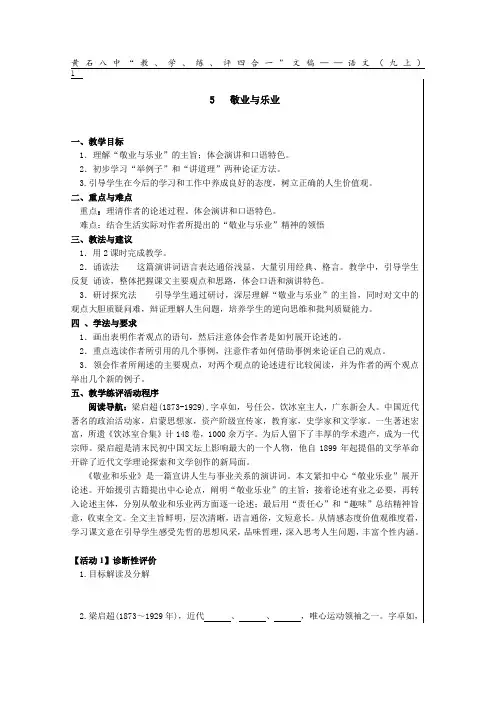
5 敬业与乐业一、教学目标1.理解“敬业与乐业”的主旨;体会演讲和口语特色。
2.初步学习“举例子”和“讲道理”两种论证方法。
3.引导学生在今后的学习和工作中养成良好的态度,树立正确的人生价值观。
二、重点与难点重点:理清作者的论述过程。
体会演讲和口语特色。
难点:结合生活实际对作者所提出的“敬业与乐业”精神的领悟三、教法与建议1.用2课时完成教学。
2.诵读法这篇演讲词语言表达通俗浅显,大量引用经典、格言。
教学中,引导学生反复诵读,整体把握课文主要观点和思路,体会口语和演讲特色。
3.研讨探究法引导学生通过研讨,深层理解“敬业与乐业”的主旨,同时对文中的观点大胆质疑问难,辩证理解人生问题,培养学生的逆向思维和批判质疑能力。
四、学法与要求1.画出表明作者观点的语句,然后注意体会作者是如何展开论述的。
2.重点选读作者所引用的几个事例,注意作者如何借助事例来论证自己的观点。
3.领会作者所阐述的主要观点,对两个观点的论述进行比较阅读,并为作者的两个观点举出几个新的例子。
五、教学练评活动程序阅读导航:梁启超(1873-1929),字卓如,号任公,饮冰室主人,广东新会人。
中国近代著名的政治活动家,启蒙思想家,资产阶级宣传家,教育家,史学家和文学家。
一生著述宏富,所遗《饮冰室合集》计148卷,1000余万字。
为后人留下了丰厚的学术遗产,成为一代宗师。
梁启超是清末民初中国文坛上影响最大的一个人物,他自1899年起提倡的文学革命开辟了近代文学理论探索和文学创作的新局面。
《敬业和乐业》是一篇宣讲人生与事业关系的演讲词。
本文紧扣中心“敬业乐业”展开论述。
开始援引古籍提出中心论点,阐明“敬业乐业”的主旨;接着论述有业之必要,再转入论述主体,分别从敬业和乐业两方面逐一论述;最后用“责任心”和“趣味”总结精神旨意,收束全文。
全文主旨鲜明,层次清晰,语言通俗,文短意长。
从情感态度价值观维度看,学习课文意在引导学生感受先哲的思想风采,品味哲理,深入思考人生问题,丰富个性内涵。
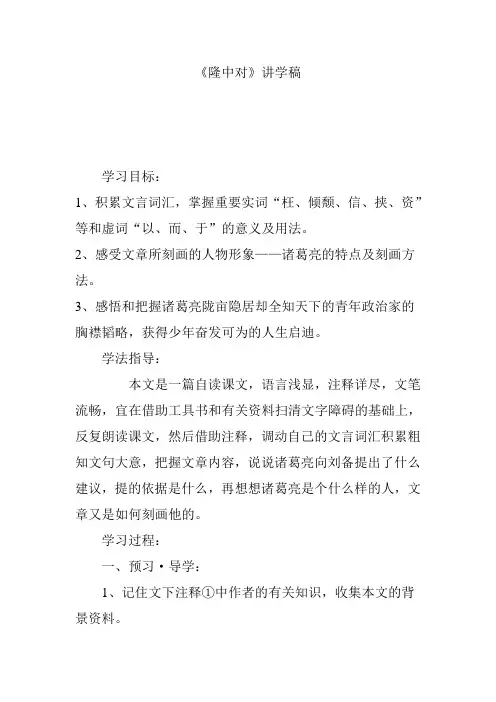
《隆中对》讲学稿学习目标:1、积累文言词汇,掌握重要实词“枉、倾颓、信、挟、资”等和虚词“以、而、于”的意义及用法。
2、感受文章所刻画的人物形象——诸葛亮的特点及刻画方法。
3、感悟和把握诸葛亮陇亩隐居却全知天下的青年政治家的胸襟韬略,获得少年奋发可为的人生启迪。
学法指导:本文是一篇自读课文,语言浅显,注释详尽,文笔流畅,宜在借助工具书和有关资料扫清文字障碍的基础上,反复朗读课文,然后借助注释,调动自己的文言词汇积累粗知文句大意,把握文章内容,说说诸葛亮向刘备提出了什么建议,提的依据是什么,再想想诸葛亮是个什么样的人,文章又是如何刻画他的。
学习过程:一、预习·导学:1、记住文下注释①中作者的有关知识,收集本文的背景资料。
2、查字典,读准下列加点字的音。
⑴好为《梁父吟》()⑵宜枉驾顾之()⑶遂诣亮()⑷因屏人()⑸度德量力()⑹遂用猖蹶()⑺挟天子而令诸候()⑻而不知存恤()⑼帝室之胄()⑽将荆州之军以向宛、洛()⑾欲信大义于天下()3、查有关资料,调动文章词汇积累,解释下列加点字。
⑴亮躬耕陇亩()⑵时人莫之许也()⑶将军岂愿见之乎()⑷此人可就见()⑸宜枉驾顾之()()⑹遂诣亮()⑺因屏人曰()⑻汉室倾颓()⑼度德量力()⑽遂用猖蹶()⑾自董卓已来()⑿不可胜数()⒀挟天子而令诸候()⒁此诚不可与争峰()⒂此殆天所以资将军()()⒃总揽英雄()⒄情好日密()⒅命一上将将荆州之军()()(19)谓谓为信然()(20)然谓为信然()谓先主曰()然志犹未已()(21)犹然志犹未已()(22)信信义著于四海( )犹鱼之有水也()欲信大义于天下( )4、诵读课文二~三遍,读准字音、节奏,培养文言语感,结合注释粗知文句意思,在此基础上,完成下面的题目:诸葛亮替刘备设计的政治蓝图是什么?为了实现这个目标他提出了哪些战略方针?依据是什么?请用文中的话回答。
(3)在自主预习的过程中,你还有哪些疑问?把它记录下来。
《闻一多先生的说和做》讲学稿目标:1、积累词语,掌握词语的读音、词义,并学会运用。
2、了解臧克家和闻一多。
知识目标1、积累一些生动形象的词句以提高自己的语言运用能力。
2、理解文章结构与选材的特色与精妙。
3、理解文章于叙述之中寓以精辟的抒情议论的技法。
能力目标1、整体把握课文内容,领会文章的思想感情。
2、学习本文围绕中心选材的方法,体会抒情、议论、描写在文中的作用。
情感态度与价值观通过用心领会闻一多先生刻苦而严谨的治学态度、无私无畏的革命斗争精神、澎湃执著的爱国爱民热忱及其言行一致的工作作风,在感受伟人革命斗争风采的同时,也从中接受启迪,以树立正确的人生观与价值观,培养顽强坚韧、无私畏的优秀品质。
教学重点1、领会过渡句段在文中的作用。
2、学习本文围绕中心选材的方法,体会抒情、议论、描写在文中的作用。
教学难点理解文中的重点语句。
教学时间:两课时第一板块:走近闻一多1、给下列加点字注音。
地壳. ( ) 仰之弥.高 ( ) 兀兀..穷年( ) 校.补 ( ) 锲.而不舍 ( ) 沥.尽心血( )赫.然 ( ) 炯炯..目光 ( ) 群蚁排衙.( ) 函.寄 ( ) 目不窥.园 ( ) 迥.乎不同( ) 漂.白 ( ) 警报迭.起 ( ) 气冲斗.牛( ) 2、文学常识填空。
《闻一多先生的说和做》作者____,现代___,山东诸城人.本文是一篇介绍闻一多先生作为__、__和__的光荣事迹的叙事散文。
知识链接:郭沫若曾惊叹闻一多的才华:“他那眼光的犀利,考索的赅博,立说的新颖而翔实,不仅是前无古人,恐怕还要后无来者的。
”朱自清曾写诗歌颂闻一多:“你是一团火,照彻了深渊;指示着青年,失望中抓住自我。
你是一团火,照明了古代;歌舞和竞赛,有力猛如虎。
你是一团火,照亮了魔鬼;烧毁了自己!遗烬里爆出个新中国!”3、释义目不窥园:诗兴不作:一反既往衰微:赫然:潜心贯注:慷慨淋漓:4、用自己的话说说:闻一多先生是一个怎样的人?__________目标:理清文章脉络5、文章从哪两个方面来写闻一多先生的说和做的?6、由此来看,文章可分为几个部分?每个部分是怎样衔接起来的?有何作用?目标:1、整体把握文章主要内容2、学习本文围绕中心选材的方法思考7-9题填写表格7、作为学者的闻一多他是怎样说的?怎样做的?8、作为学者的闻一多有哪些主要成就?9、作为民主战士的闻一多是怎样说的、怎样做的?10、课文记叙了作为革命者的闻一多的哪三件事?11、作者选取闻一多先生作为学者列举的三件事,选择的角度是什么?详略安排有什么不同?12、闻一多先生前期和后期思想品格上的主要特点是什么?前后期有什么变化?又有什么共同的地方?13、闻一多先生经历复杂,著作等身,可记述的事很多很多。
八年级语文教案散步讲学稿9篇散步讲学稿 1教学过程及要点:一、预习设计:1、朗读课文,自己查字典,解决字的读音,找出一两个课下注释中没有,你又不理解的字词,准备课上交流。
2、准备好字词积累本、字典、词典。
3、阅读课文,思考、讨论下列语句的含义:(1)我说正因为如此,才应该多走走。
(2)她现在很听我的话,就象我小时候很听她的话一样。
(3)我决定委屈儿子,因为我伴他的时日还长。
(4)但是母亲摸摸孙儿的脑袋瓜,变了主意:“还是走小路吧!”(5)但我和妻都是慢慢地、稳稳地,走得很仔细,好像我背上的同她背上的加起来,就是整个世界。
二、学习新课:(一)课:这节课我们学习《散步》这篇文章,在学习本文的时候,我们要注意体会本文与《金黄的大斗笠》的相同点和不同点。
(二)同桌之间交流字词整理情况,教师巡回指导。
要求学生将自己和同桌找出的字词都通过查字、词典,根据语言环境,准确无误地注音、注释。
(三)师范读课文,学生在下面小声或不出声跟读,体会读音、重音、语调、语速,看有无不恰当的地方,标记下来。
(读后师生共同讨论、订正。
学生说出自己的读法以后,对有道理的要充分肯定,认为没有道理的,归为“一种认识”一类,一般不宜直接否定;学生说出想法后,让其读给大家听)(四)讨论、品味重要语句:1、我说正因为如此,才应该多走走。
要点:表现了儿子对母亲的关心。
2、她现在很听我的话,就象我小时候很听她的话一样。
要点:因为我从小很听话,母子感情很深,所以母亲现在很信任我。
3、我决定委屈儿子,因为我伴他的时日还长。
要点:爱幼尊老。
4、但是母亲摸摸孙儿的小脑瓜,变了主意:“还是走小路吧。
”要点:表现了母亲对孙子的爱,牺牲自己的意愿,满足孙子的意愿。
5、但是,我和妻都慢慢地、稳稳地,走得很仔细,好象我背上的同她背上的加起来,就是整个界。
要点:人到中年,肩负承前启后的责任,对生活有一种使命感。
(五)师齐读课文,体会文中感情,思考:和《金黄的大斗笠》的相同点与不同点是什么?1、指导思想:让学生讨论,畅所欲言,言之有理即可。
《谏太宗十思疏》讲学稿一、教学目标(1)理解作者的观点及理想的政治境界。
(2)培养对文言文的感悟、诵读和背诵能力,及学习作者反复开导、循循善诱的劝谏艺术,培养说理能力。
(3)认识"十思"在当时的作用和今天的借鉴意义。
二、重点难点1、诵读、领悟,背诵全文。
2、翻译难懂的语句。
三、课时安排三课时第一课时(一)导语讽谏帝王,是冒险的事。
批"龙鳞",逆"圣听",需要大勇与大智。
多少忠臣义士。
尽忠进谏,结果呢?有的被挖心,有的被放逐。
比干、屈原的故事,千古流传。
但是,唐代著名谏官魏征进谏唐太宗,却大多被采纳,不但没有招来杀身之祸,还经常得到唐太宗的表扬。
魏征写了《谏太宗十思疏》上奏后,唐太宗非常赞赏,亲手写诏嘉许魏征,并放置案头,以资警惕"让我们一起来欣赏一下他是怎么写这篇文章的。
(二)作者简介魏征(580-643),宇玄成,唐曲城(今属河北)人,后迁居相州内黄(今河南内黄)。
少时曾出家为道十,隋末参加瓦岗起义军,后降唐。
唐太宗时拜谏议大夫、检校侍中等职,领导周、隋、陈、齐诸史的撰修工作。
后封郑国公,任太子太师。
魏征在历史上以能犯颜直谏著称,前后陈谏二百余事,多被太宗采纳。
魏征提倡"无面从退有后言","爱而知其恶,憎而知其善",建议太宗广开言路,认为"兼听则明,偏信则暗"。
魏征病卒后,唐太宗痛惜“遂亡一镜矣”。
(三)题解历史背景:这是贞观十一年(公元637年)魏征写给唐太宗的奏章。
唐太宗初年励精图治,颇称英明。
后来却追求珍宝异物,兴建宫殿园囿,魏征就不断用前代兴亡的历史教训来提醒他。
这一个魏征连上四疏。
本文是其中的一篇。
文章写得语重心长,剀切深厚。
全文围绕“思国之安者,必积其德义”的主旨,规劝唐太宗在政治上要慎始谨终,虚心纳下,赏罚公正;用人时要知人善任,简能择善;生活上要崇尚节俭,不轻用民力。
《新闻两则》导学案班级姓名评价预习目标1.能熟读课文,熟悉文章写作背景2.掌握生字词及文学常识3.了解作者所表达的思想感情、写作目的,谈自己学文章之后的感受及体会4.摘抄积累新闻的有关知识第一课时《人民解放军百万大军横渡长江》一、预习·导学1.走近毛泽东(查阅资料,把你知道的有关作者的知识写在下面)。
2、走进新闻新闻:从广义来讲包括消息、通讯、报告文学;从狭义来讲,就是指消息。
①新闻的特点:真实性、及时性、简明性。
②新闻的要素:即记叙的六要素(人物、时间、地点、事件原因、经过、结果。
)③新闻的基本结构:从结构上说,一则新闻通常不可缺少的三部分是标题、导语和主体。
标题:就是消息的题目,通常是概括消息中最主要的内容和含意,要求明确、简练、突出。
导语:就是消息的第1段或开头的一两句话,它一般是对事件或事件中心的概述。
主体:就是消息的主要部分,它要对导语所概括的事实作比较具体的叙述,用足够的、典型的材料来表现主题。
另,还有背景和结语,有时暗含在主体中。
背景:介绍新闻发生的社会环境和自然环境。
阅读时注意分清消息中标题、导语和主体这三部分。
3、字词积累①注音鄂()豫()绥靖()阻遏()()泄气()溃退()歼灭()管辖()锐不可当()上当()要塞()瓶塞()阻塞()堵塞()②词语解释锐不可当——业已——绥靖——4、理清《人民解放军百万大军横渡长江》的六要素:人物:时间:地点:事件发生的原因:经过:结果:二、学习·研讨【学习目标】1、理解课文,了解新闻消息的特点,并能进行简单分析2、体会语言的准确精练、铿锵有力,提高语言表达能力。
3、增进学生对新中国创建历史的了解,引导学生接受革命传统教育,学习革命前辈英勇奋斗的精神。
【学习重点】1、把握课文内容,了解新闻消息的一般特点2、体会本文准确简洁的语言风格【教学难点】:引导学生接受革命传统教育,提高学生阅读的质量和速度【学习过程】:(一)把握内容1、自由朗读课文。
《口技》讲学稿姓名学习目标:1、准确流畅地朗读课文,培养文言语感。
2、掌握重点字、词、句的意义及用法,积累文言知识。
3、学习本文正面描写和侧面描写相结合的写法。
4、了解我国口技艺人高度的聪明才智和艺术创造能力。
学习重难点:1.积累词语,背诵全文。
2. 学习本文正面描写和侧面描写相结合的写法,培养写作能力。
学习时数:2课时预习导学:1.了解口技口技是民间的表演技艺,是杂技的一种。
古代的口技实际上只是一种仿声艺术。
表演者用口摹仿各种声音,能使听的人产生一种身临其境的感觉,是我国文化艺术的宝贵遗产之一。
这种技艺,清代属“百戏”之一种,表演者多隐身在布幔或屏风后边,俗称“隔壁戏”。
且其中还有腹语术。
运用嘴、舌、喉、鼻、等发音技巧来模仿各种声音,如火车声、鸟鸣声等,表演时配合动作,可加强真实感。
2.了解作家作品本文选自《》,这本书是(朝代)的编选的一部笔记小说集。
本文的作者是(朝代)的。
3.熟读课文,给下列字词注音。
林嗣.环()屏.障()少顷..()()倾.()侧呓.()语齁.()声中间.()崩.()曳.()屋许许.()声几.()欲哗.()补充:4.逐字翻译该文,将不会翻译的字词句做上记号学习过程:一.导入交流预习导学。
二.读1.范读,注意字音,句读。
2.自由读,准确、流畅。
3.指名读、齐读。
三.译(先逐句翻译,然后全文整体翻译。
)1.京中有善口技者。
会宾客大宴,2.于厅事之东北角,施八尺屏障,3.口技人坐屏障中,一桌、一椅、一扇、一抚尺而已。
4.众宾团坐。
少顷,但闻屏障中抚尺一下,5.满坐寂然,无敢哗者。
6.遥闻深巷中犬吠,便有妇人惊觉欠伸,其夫呓语。
7.既而儿醒,大啼。
夫亦醒。
8.妇抚儿乳,儿含乳啼,妇拍而呜之。
9.又一大儿醒,絮絮不止。
10.当是时,妇手拍儿声,口中呜声,儿含乳啼声,大儿初醒声,夫叱大儿声,一时齐发,众妙毕备。
11.满坐宾客无不伸颈,侧目,微笑,默叹,以为妙绝。
12.未几,夫齁声起,妇拍儿亦渐拍渐止。
杏坛讲学稿子
各位同学,欢迎来到今天的讲学会。
今天我们将要讨论的话题是关于汉语和英语的结合应用。
作为一种全球通用的语言,英语在我们的日常生活中扮演着重要的角色,而汉语作为一种古老而丰富的语言,也是我们中华民族的文化传承。
将这两种语言结合起来,不仅可以增加我们的语言表达能力,还可以更好地传承和发扬我们的民族文化。
首先,我们可以通过使用英语学习中文,或者通过中文学习英语来丰富我们的语言知识。
比如,我们可以通过阅读英语文章学习新的中文词汇,或者通过看中文电影学习新的英语单词。
在这个过程中,我们不仅可以提高我们的语言水平,还可以拓宽我们的视野,了解更多不同文化背景下的表达方式。
其次,我们可以通过结合使用中英文来增强我们的语言表达能力。
比如,在写作文时,我们可以运用英语的逻辑思维方式,来帮助我们更清晰地组织中文的表达内容。
或者,在日常交流中,我们可以用英语来解释一些中文的独特含义,让对方更好地理解中文的文化内涵。
通过这样的结合运用,我们不仅可以提高我们的语言能力,还可以增加我们的沟通能力,让我们更加自信地与世界进行交流。
最后,我们要记住,语言是文化的载体,只有真正理解并尊重对方的语言和文化,我们才能实现真正的跨文化交流。
所以,在学习中英文的过程中,我们要注重对中英文背后文化内涵的理解,并尊重不同文化体系下的表达方式。
只有这样,我们才能更好地传承和发扬我们的中英文化。
以上就是我今天的分享,希望对大家有所启发。
谢谢大家!。
“讲学稿”
镇原县孟坝初级中学,初二(3)班,一节普通的语文课。
记者走进教室时,学生们显得很自然,没有人感到惊奇和紧张,似乎早习以为常了。
因为在此之前,前来学校听课、学习交流、考察调研的人不下数百人。
让这么多人慕名前来的正是学校正在实行的“讲学稿”(以讲学稿为特征的教学模式――编者注)。
课前,语文课代表拿着一沓试卷模样的纸――讲学稿,每人一张分发给全班同学。
上课铃一响,老师只拿着一本课本走进教室。
这节课所学的课文是《敬畏自然》。
正式上课后,老师让学生列举一些人类“征服”自然的事例,顺着问题的思路,引入了课文。
在上课的过程中,老师似乎并没有“讲课”,不是提问就是让学生自主学习。
更多的是让学生分组讨论或回答问题,除了指出几个知识点之外,老师没有强调哪些是要记的,哪些是该背的,学生也没有抄笔记,课堂上气氛活跃,节奏明快。
一节课下来,给记者的印象是,学生真正成了课堂的主人,老师似乎只是一个穿针引线的人。
下课后,老师没有给学生布置任何作业。
同时记者注意到,一
节课只上了40分钟。
困境中的探索
这种教学模式在孟坝初中实行已5年了。
说起“讲学稿”,就不得不提一下学校的历史和现任校长吴琦。
孟坝初级中学成立于1995年,是一所独立初中。
在孟坝镇,还有一所办学历史近半个世纪的学校――孟坝中学,学校办学实力雄厚,是学生、家长公认的好学校,上孟坝中学成了所有学生的目标。
“优等生源都去了孟坝中学。
”吴琦说,“学校在成立后的十年间,排名几乎年年都是倒数,是镇原县有名的落后学校。
”
2004年,吴琦调入孟坝初级中学,被任命为校长。
那一年,镇原县开始实施新课程改革。
在实施过程中,学校遇到了许多问题和困惑。
孟坝初中与许多学校一样,先后多次到新课改实验先进地区考察学习。
在江苏省溧水县东庐中学,学校首创实行的“讲学稿”教学模式让吴琦眼前一亮。
回来后,学校便开始研究引入这种教学模式的可行性。
“理念不更新,学校办学水平只能在原地踏步。
”吴琦说,“我们学校在师资力量等各个方面,都处劣势
地位,无论老师怎么努力,学校始终无法摆脱排名倒数的现实。
”
于是,吴琦数次带领老师到东庐中学学习交流。
从2005年10月起,孟坝初中正式引入并实行起了“讲学稿”教学模式。
这种教学模式对学生来说是陌生的,甚至当地许多老师听都没有听过。
“实行这种教学模式,就西部五省来说,我校大概属于首家。
”吴琦说,“很多家长包括一部分老师都抱着怀疑的态度,人们无法接受这样一种‘闻所未闻’的东西。
”
在无数人怀疑的目光中,孟坝初中的老师承受着巨大的压力开始运用起了“讲学稿”。
“这是一个不容失败的事。
”吴琦谈到实行初期时的压力时,似乎还“心有余悸”,“那一年,我的头发都掉了许多。
老师们也一样,不但要学习、领会‘讲学稿’的精髓,而且还要在课余时间编印讲学稿,工作量大大超出了平时。
但是,为了一个信念,为了把‘讲学稿’真正运用好,所有老师都拼命地工作。
”
“最初,难免会出现形式主义。
”由于各种原因,在课堂上,不少老师常常是顾此失彼,不是“照猫画虎”,就是疏忽主旨。
为此,吴琦先后组织老师到东庐中学学习,和东庐中学的老师一起备课,听课,借班
讲课,从中找差距,积累经验。
孟坝初中在走出去学习交流的同时,还邀请东庐中学的老师前来讲课。
两校也结成了友好学校,每学期互派教师交流学习。
经过几年的学习和提升,孟坝初中在借鉴的同时不断创新,在教学方式上体现出了自己的特色,教学水平不断提高,学校也因此走出了困境,在全县的排名和升学率都大幅提高。
“2007年,学校从排名倒数一跃到了中间。
”说
起学校在实行“讲学稿”后的变化,吴琦显得有点欣慰和自豪。
讲学稿是什么
在采访的过程中,记者了解到,讲学稿既是具体的教学文本也是一种教学模式。
具体的讲学稿是老师和学生共同的一种教案和学案的结合体。
“通俗一点讲,它是集教案、学案、作业、测试和复习资料于一体的师生共用的教学文本。
”吴琦解释说,“在讲学稿上,有教案中所强调的教学目标、课程目标,有学生学习的知识点和重难点,也有供学生练习用的习题。
”另外,孟坝初中还在设计时加入了老师的“教学反思”和学生的“学后记”。
讲学稿编印完成后,教师将讲学稿提前发给学生,学生预习后交给教师,教师批阅后课前再发给学生,然后师生共用这一文稿进行课堂教学。
按照讲学稿的设计,在课堂上老师讲课不超过15分钟,其原因在于,在课前老师通过讲学稿已经了解到了学生学习的相关信息,即哪些内容学生已理解,哪些内容是普遍存在问题的,哪些内容是个别学生没有掌握的。
“学生会做的我们不讲,我们主要讲重点、难点、易混点。
”初二年级的一位语文老师说,“在课堂上放手让学生思考、讨论,然后进行适量练习,让全体学生边练习边订正错误,把学生没有理解的知识当堂消化掉,这是一堂课的任务。
”
其实,“讲学稿”这种教学模式并不复杂,它似乎是把传统教学模式下老师的教和学生的学“前置化”了。
在传统教学模式下,虽然老师要求学生在课前预习,但是,大部分自学能力弱的学生不知道该预习什么。
这种教学模式则不同,讲学稿上清楚地指出了预习的内容和需要掌握的知识点,甚至包括一部分练习。
在正式上课前,学生根据讲学稿通过自学,几乎掌握了大部分内容,在正式上课时,教学双方都心中有数,便可做到轻车熟路。
“讲学稿是一个比较系统化的教学载体。
”学校的一位英语老师这样说到,“课后,我们还要在讲学稿上写‘课后记’,针对课堂教学情况形成‘错题集’,用作下次集中备课交流时的补充和‘周周清’;学生也要填写‘学后记’,列出复习时注意的问题。
”
讲学稿是怎样“炼”成的
说到讲学稿的编写,吴琦的体会很深。
为了让讲学稿体现出它的特色,吴琦作为校长数年来一直坚持代课,在实践中找灵感和经验。
“讲学稿是集体智慧的结晶。
”孟坝初中把讲学稿的编写与集体备课结合起来。
根据学科对教学内容进行分工,每位教师轮流主备,形成初稿。
初稿形成后再由备课组全体教师讨论修改,然后由学校分管领导提出修改意见后定稿。
讲学稿对老师的要求很高,也对老师有很大的促进。
“在这几年中,老师虽然工作量大,任务重,但是对教学的理解和把握程度可以说是今非昔比了。
”吴琦这样评价讲学稿带来的好处。
经过几年来的实践和摸索,孟坝初中和学校实行的“讲学稿”教学模式在当地已是“小有名气”了,
先后有数所学校前来“取经”,还被教育厅确定为试验项目。
减负的良药,新课改的抓手
减负是这些年来学校的一个“老大难”问题,学生负担重的原因很多,其中一个明显的特征就是课外作业
多。
但是,在应试教育下,学校和老师都显得很无奈――不能如此但不能不如此。
“作业就是讲学稿。
”在课间记者问到做作业的情况时,几位学生这样说道,“我们没有课外作业。
”同学生交流时,记者注意到,学生对讲学稿的好处说得最多的就是“我们的负担轻了”。
在当前,许多人在为学生负担重而“焦头烂额”时,“讲学稿”这种教学模式却像一阵凉风,让人感到分外惬意。
它如同一剂良药,让陷入“题海战”中的师生醒过神来。
同时,它也给新课改的实施找到了一个抓手,让新课改有了一个基点,有了一种途径。
而不是像许多人担忧和批评的那样――许多学校实施新课改是在穿新鞋走老路,换汤不换药,打着新课改的旗子,却进
行着甚于传统模式的“题海战”和“分数战”。
在采访的过程中,给记者感触最深的是,“讲学稿”不是什么灵丹妙药,而是扎根在课堂、讲求方法的一种创新理念,一种教学方式,教学理念才是其中最根本的东西,讲学稿只是理念的一种形式和载体。
在实施素质教育和新课改的今天,用行动和智慧来践行教育理念,孟坝初中所实行的“讲学稿”就是一种有益的尝试。